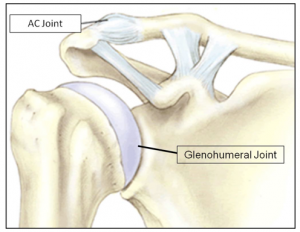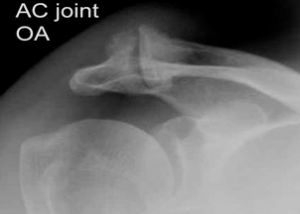Acromioclavicular (AC) Joint Arthrosis
The bones of the shoulder girdle create two distinct joints: 1) the glenohumeral joint is the ball and socket joint, where most of the shoulder motion occurs; 2) the acromioclavicular (AC) joint is where the collar bone (clavicle) attaches to the shoulder blade (acromion).
AC joint arthrosis (another term for arthritis) is a common degenerative condition that occurs with age. Just like arthritis in other joints, in AC joint arthrosis there is narrowing of the space between the bones of the joint, in this case the acromion and the clavicle. Bone spurs develop in this area, and the lining of the joint becomes inflamed.
Occasionally this condition may occur following an AC joint injury (or shoulder separation), but more commonly this is a degenerative process that occurs gradually over time in the aging population. Weightlifters who perform repetitive overhead lifting activities place significant stress across the AC joint and are more prone to develop AC joint arthrosis.
Signs & Symptoms:
Frequently AC joint arthrosis is asymptomatic, but some patients may experience significant symptoms related to this condition. Pain and ternderness on the top of the shoulder, in the area of the AC joint, is the most common symptom of AC joint arthrosis. The pain is often worse when the arm is brought across the chest, since this motion compresses the joint.
Diagnosis:
The diagnosis of AC joint arthrosis is typically made on the basis of the patient’s history, the physical examination findings, and x-ray findings. Frequently an MRI is obtained to exclude other potential causes of shoulder pain.
Treatment:
The treatment of AC joint arthrosis is initially non-operative. Treatment modalities include: rest, activity modifications, ice, and anti-inflammatory medications. If these measures are not effective a cortisone injection into the AC joint may be performed. This may provide temporary relief or may provide long lasting benefit. If non-operative measures fail, surgical treatment may be considered. Surgery is performed using arthroscopic techniques to resect the affected portion of the clavicle.
Hear Dr. Farber Describe a Distal Clavicle Resection


